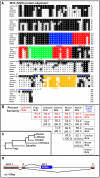Mrf4 (myf6) is dynamically expressed in differentiated zebrafish skeletal muscle
- PMID: 17638597
- PMCID: PMC3001336
- DOI: 10.1016/j.modgep.2007.06.003
Mrf4 (myf6) is dynamically expressed in differentiated zebrafish skeletal muscle
Abstract
Mrf4 (Myf6) is a member of the basic helix-loop-helix (bHLH) myogenic regulatory transcription factor (MRF) family, which also contains Myod, Myf5 and myogenin. Mrf4 is implicated in commitment of amniote cells to skeletal myogenesis and is also abundantly expressed in many adult muscle fibres. The specific role of Mrf4 is unclear both because mrf4 null mice are viable, suggesting redundancy with other MRFs, and because of genetic interactions at the complex mrf4/myf5 locus. We report the cloning and expression of an mrf4 gene from zebrafish, Danio rerio, which shows conservation of linkage to myf5. Mrf4 mRNA accumulates in a subset of terminally differentiated muscle fibres in parallel with myosin protein in the trunk and fin. Although most, possibly all, trunk muscle expresses mrf4, the level of mRNA is dynamically regulated. No expression is detected in muscle precursor cell populations prior to myosin accumulation. Moreover, mrf4 expression is not detected in head muscles, at least at early stages. As fish mature, mrf4 expression is pronounced in the region of slow muscle fibres.
Figures



Similar articles
-
Overlapping functions of the myogenic bHLH genes MRF4 and MyoD revealed in double mutant mice.Development. 1998 Jul;125(13):2349-58. doi: 10.1242/dev.125.13.2349. Development. 1998. PMID: 9609818
-
Inactivation of the myogenic bHLH gene MRF4 results in up-regulation of myogenin and rib anomalies.Genes Dev. 1995 Jun 1;9(11):1388-99. doi: 10.1101/gad.9.11.1388. Genes Dev. 1995. PMID: 7797078
-
Failure of Myf5 to support myogenic differentiation without myogenin, MyoD, and MRF4.Dev Biol. 2000 Mar 15;219(2):287-98. doi: 10.1006/dbio.2000.9621. Dev Biol. 2000. PMID: 10694423
-
Function of the myogenic regulatory factors Myf5, MyoD, Myogenin and MRF4 in skeletal muscle, satellite cells and regenerative myogenesis.Semin Cell Dev Biol. 2017 Dec;72:19-32. doi: 10.1016/j.semcdb.2017.11.011. Epub 2017 Nov 15. Semin Cell Dev Biol. 2017. PMID: 29127046 Review.
-
Regulation and functions of myogenic regulatory factors in lower vertebrates.Comp Biochem Physiol B Biochem Mol Biol. 2001 Aug;130(1):1-12. doi: 10.1016/s1096-4959(01)00412-2. Comp Biochem Physiol B Biochem Mol Biol. 2001. PMID: 11470439 Review.
Cited by
-
Phylogenetic analysis of zebrafish basic helix-loop-helix transcription factors.J Mol Evol. 2009 Jun;68(6):629-40. doi: 10.1007/s00239-009-9232-7. Epub 2009 May 16. J Mol Evol. 2009. PMID: 19449054
-
Defective cranial skeletal development, larval lethality and haploinsufficiency in Myod mutant zebrafish.Dev Biol. 2011 Oct 1;358(1):102-12. doi: 10.1016/j.ydbio.2011.07.015. Epub 2011 Jul 23. Dev Biol. 2011. PMID: 21798255 Free PMC article.
-
Dynamic transcriptome and histomorphology analysis of developmental traits of hindlimb thigh muscle from Odorrana tormota and its adaptability to different life history stages.BMC Genomics. 2021 May 20;22(1):369. doi: 10.1186/s12864-021-07677-0. BMC Genomics. 2021. PMID: 34016051 Free PMC article.
-
Potential Mechanism and Effects of Different Selenium Sources and Different Effective Microorganism Supplementation Levels on Growth Performance, Meat Quality, and Muscle Fiber Characteristics of Three-Yellow Chickens.Front Nutr. 2022 Apr 15;9:869540. doi: 10.3389/fnut.2022.869540. eCollection 2022. Front Nutr. 2022. PMID: 35495956 Free PMC article.
-
Differentiation and Maturation of Muscle and Fat Cells in Cultivated Seafood: Lessons from Developmental Biology.Mar Biotechnol (NY). 2023 Feb;25(1):1-29. doi: 10.1007/s10126-022-10174-4. Epub 2022 Nov 14. Mar Biotechnol (NY). 2023. PMID: 36374393 Free PMC article. Review.
References
-
- Baxendale S, Davison C, Muxworthy C, Wolff C, Ingham PW, Roy S. The B-cell maturation factor Blimp-1 specifies vertebrate slow-twitch muscle fiber identity in response to Hedgehog signaling. Nat Genet. 2004;36:88–93. - PubMed
Publication types
MeSH terms
Substances
Grants and funding
LinkOut - more resources
Full Text Sources
Molecular Biology Databases
Research Materials
Miscellaneous

